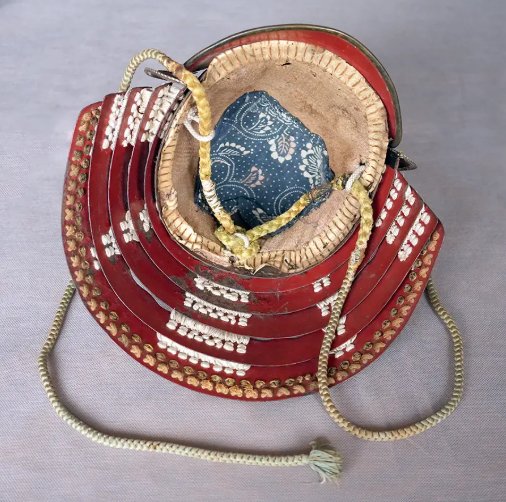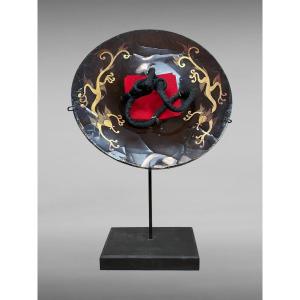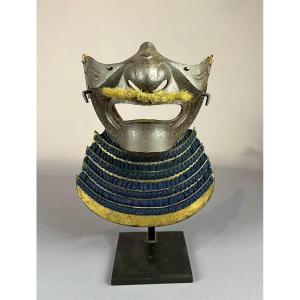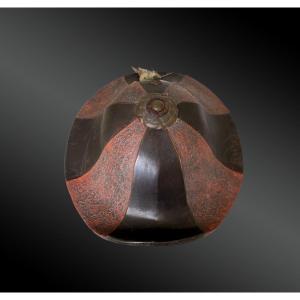Helmet (kabuto): Lacquered to imitate twenty-four plates, with a tehen kanamono in the shape of a flower — a decorative symbol placed at the top of the helmet. Neck guard (shikoro): Etchu type, composed of three black and gold lacquered plates, laced in white. Mask (menpō): Ressei type, made of black lacquered iron, featuring a beige mustache made from wild boar hair (Sus scrofa japonica). The interior is lacquered red for both aesthetic and preservation purposes. Throat guard (yodarekake): Made of black lacquered iron, composed of three laced plates. Cuirass (dō): Iyozane nimai-dō type, crafted from iron covered with black lacquered leather, marking the transition between functional protection and refined aesthetics. Skirt (kusazuri): Composed of five black lacquered iron plates, laced in white, offering flexibility and protection to the lower torso. Shoulder guards (sode): Made of black lacquered iron, with seven white-laced plates. Arm guards (kote): Shino type, made of black lacquered iron and fabric. Thigh guard (haidate): Composed of black lacquered kawara iron plates, attached to blue fabric to protect the thighs. Shin guards (suneate): Shino type, made of black lacquered iron with blue fabric. Command baton (sai hai): Made of black lacquered wood and paper, used for giving orders on the battlefield. Storage box (yoroi bitsu): Wooden box used to store and transport the armor. (Some parts of the armor show minor damage.) Specific Features of Edo-Period Dō Cuirasses The dō cuirasses from this period reflect a subtle balance between warrior tradition and technical evolution. The iyozane dō, made of small interlocking plates covered in lacquered leather, preserves the legacy of earlier armor styles. It was made lighter to meet the needs of Edo-period samurai. This era, marked by relative peace under the Tokugawa shogunate, saw a decline in open warfare and a rise in the symbolic and ceremonial importance of armor. Black lacquer, often paired with gold or white accents, emphasizes the elegance and sophistication characteristic of Edo armor. The meticulous lacing work and careful selection of materials also demonstrate a focus on both aesthetics and durability. Additionally, cuirasses were often personalized, allowing the samurai to express his identity, rank, and clan affiliation.














































 Le Magazine de PROANTIC
Le Magazine de PROANTIC TRÉSORS Magazine
TRÉSORS Magazine Rivista Artiquariato
Rivista Artiquariato